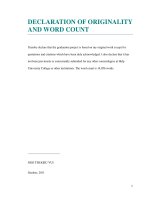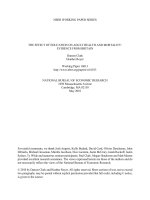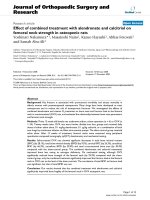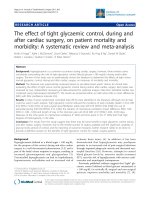The effect of periodontal cell sheet wrapping and cell dipping co culturing techniques in delayed replanted canine teeth
Bạn đang xem bản rút gọn của tài liệu. Xem và tải ngay bản đầy đủ của tài liệu tại đây (2.26 MB, 118 trang )
THE EFFECT OF PERIODONTAL CELL SHEET WRAPPING AND
CELL DIPPING CO-CULTURING TECHNIQUES IN DELAYED
REPLANTED CANINE TEETH
DO DANG VINH
(Bsc, NUS)
A THESIS SUBMITTED
FOR THE DEGREE OF MASTER OF SCIENCE
DEPARTMENT OF RESTORATIVE DENTISTRY
FACULTY OF DENTISTRY
NATIONAL UNIVERSITY OF SINGSPORE
2009
ii
Supervisors
A/Prof VARAWAN SAE-LIM
Department of Restorative Dentistry
Faculty of Dentistry
National University of Singapore
A/Prof PHAN TOAN THANG
Department of Surgery
Yong Loo Lin School of Medicine
National University of Singapore
iii
DEDICATION
To my family and friends who had helped and supported me
i
ACKNOWLEDGEMENTS
I would like to thank A/Prof Varawan Sae-Lim and A/Prof Phan Toan Thang for their kind
guidance, advice and patience.
I would like to thank A/Prof Chan Yiong Huak and Dr Shen Liang for their kind guidance
and advice on statistical evaluation.
I would like to thank the staffs at Animal Holding Unit, Tang Tock Seng Hospital, and
NUS staffs Mr Chan Swee Heng, Ms Angeline Han, Ms Yuan Jun Xia for their constant
help.
I would like to thank my colleagues Dr Tarun, Dr Chung Tze Onn, Dr Lim Siew Hooi, Dr
Terrence and Dr Serine for their support and help in this project.
I would finally like to acknowledge the National University of Singapore for supporting
me with NUS Research Scholarship.
ii
TABLE OF CONTENTS
Dedication
i
Acknowledgements
ii
Table of contents
iii
List of tables
viii
List of figures
ix
Summary
1
1. Introduction
3
2. Literature review
5
2.1 Periodontium
2.1.1
Structure and organization of periodontium
2.1.2
Development of periodontium
2.1.3
Gingiva
2.1.4
Cementum
2.1.5
Periodontal ligament
2.1.6
Alveolar bone
2.2 Wound healing
2.2.1
5
10
Phases of wound healing
iii
2.2.2
Wound healing in extraction socket
2.2.3
Periodontal healing in replanted tooth
2.3 Avulsion
2.3.1
Epidemiology
2.3.2
Sequelae of replanted avulsed tooth
2.3.3
Factors affecting periodontal healing
2.3.4
Treatment strategies
2.4 Periodontal regeneration
2.4.1
Biomatrices
2.4.2
Biomolecules
2.4.3
Cell-based approaches
14
26
2.4.3.1 Cell-based therapy in periodontal defects
2.5 Potential cell sources for cell-based therapy for delayed tooth replantation 31
2.5.1
Cell sources for periodontal regeneration
2.5.2
Cell sources for cemental regeneration
3. Objectives
35
3.1 Aim of the study
35
3.2 Uniqueness of the study
35
iv
3.3. Rationale of the study
4. Materials and Methods
36
38
4.1 Animal preparation
38
4.2 Teeth harvesting
38
4.3 Cell culture preparation
39
4.4 Tooth preparation
39
4.5 Co-culture procedures
40
4.5.1 Cell sheet wrapping
4.5.2 Cell dipping co-culturing
4.6 Implantation procedures
41
4.7 Specimen processing
42
4.8 Histomorphometric evaluation
43
4.9 Statistical evaluation
44
5. Results
5.1 Results of cell culture
45
45
5.1.1 Cell culture preparation
5.1.1 Cell sheet wrapping
5.1.2 Cell dipping co-culturing
v
5.2 Results of radiographs
47
5.3 Results of histomorphometric evaluation
47
5.3.1
Negative control group
5.3.2
Positive control group
5.3.3
Cell sheet wrapping groups
5.3.4
Cell dipping co-culturing groups
5.3.5
Further statistical analysis
6. Discussion
6.1 Experimental design
6.1.1
Canine model selection
6.1.2
Root hemisection
6.1.3
Tooth preparation
6.1.4
Cell culture preparation
6.1.5
Cell sheet wrapping technique
6.1.6
Cell dipping co-culturing technique
6.1.7
Implantation protocol
6.1.8
6-weeks and 12-weeks observation period
6.1.9
Histological evaluation
53
53
vi
6.2 Analysis of results
60
6.2.1
Negative control/Positive control group
6.2.2
Cell sheet wrapping group
6.2.3
Cell dipping co-culturing group
6.2.4
Comparison between cell sheet wrapping technique and cell dipping co-
culturing technique
6.3 Limitation
65
7. Conclusion
66
8. Future direction
67
9. Bibliography
69
10. Appendices
78
vii
LIST OF TABLES
Table 1. Comparison between different cell sheet wrapping techniques.
Table 2. Comparison between different cell dipping co-culturing techniques.
Table 3. Statistical comparison of different periodontal healing pattern for different
groups.
viii
LIST OF FIGURES
Fig 1. Structure of tooth.
Fig 2. Histology of periodontium.
Fig 3. Sequelae of avulsion injury.
Fig 4. Overall experimental design
Fig 5. A) Diagram demonstrating teeth available for extraction and root canal treatment.
B) Sequence of procedures for each tooth during teeth harvesting.
Fig 6. Sequence of procedures for each tooth in preparation for cell culture.
Fig 7. Sequence of procedures for each tooth during cell culturing.
Fig 8. Sequence of procedures for each tooth during tooth preparation.
Fig 9. Sequence of procedures for each tooth during cell sheet wrapping.
Fig 10. Sequence of procedures for each tooth during cell dipping co-culturing.
Fig 11. Sequence of procedures for implantation for roots in cell-sheet wrapping and cell
dipping co-culturing groups.
Fig 12. Sequence of procedures for histological processing.
Fig 13. Histomorphometric analysis of the periodontal healing patterns in the replanted
roots.
Fig 14. Radiographs of the representative roots in negative control group (A), positive
control group (B), cell sheet wrapping group (C), cell dipping co-culturing group (D).
ix
Fig 15. Histologic photomicrographs of the negative control group (N) in which
immediate replantation resulted in favorable healing.
Fig 16. Histologic photomicrographs of the positive control group (P) in which 1-hour
delayed replantation resulted in replacement resorption.
Fig 17. Histologic photomicrographs of the cell sheet wrapping group (CS) illustrating
favorable healing.
Fig 18. Histologic photomicrographs of the cell sheet wrapping group (CS) showing
replacement resorption.
Fig 19. Histologic photomicrographs of the cell dipping co-culturing group (CD)
illustrating favorable healing.
Fig 20. Histologic photomicrographs of the cell dipping co-culturing group (CD) showing
replacement resorption.
x
SUMMARY
Background: Prolong delayed tooth replantation results in the necrosis and damage of
the root surface periodontal tissue that poses a critical-sized periodontal defect leading
to the adverse consequences of ankylosis and replacement resorption with eventual
tooth loss. Our study adopted autologous periodontal ligament cell-based therapy as
previous studies using physico-chemical methods have not shown to be predictably
successful.
Aim: This study aimed to evaluate and compare the effect of periodontal cell-sheet
wrapping and cell dipping co-culturing techniques in periodontal regeneration and
prevention of ankylosis and replacement root resorption in delayed replanted teeth in
dog model.
Methods: Four canine roots each in the negative and the positive control groups were
endodontically treated, extracted, replanted immediately and after one-hour bench-dry,
respectively. Eighteen experimental roots were extracted for periodontal fibroblasts
explant. The latter was subcultured with medium containing 200 μg/ml Ascorbic acid
while the roots were surface-denuded, endodontically treated, sterilized and conditioned
with 17% EDTA. These treated roots were either dipped in cell suspension of 10x106
PDL fibroblasts (8 roots) or cell sheet wrapped (10 roots). The cell-coated roots were
subsequently replanted according to a submerged protocol. After 6-weeks and 12weeks, the roots and the jaw bone were harvested, step-serially sectioned and
1
histomorphometrically evaluated. Statistical analyses were performed using KruskalWallis and Mann-Whitney U tests.
Results: For the negative control group (N) in which the roots were replanted
immediately, there was high occurrence of favorable healing (87.19%) and low
occurrence of replacement resorption (2.81%). For the positive control group (P) where
the roots were replanted after 60-min bench-dry, there was low occurrence of favorable
healing (4.17%) and high occurrence of replacement resorption (83.64%). In
comparison, cell sheet wrapping group (CS) had high occurrence of favorable healing at
both 6-weeks and 12-weeks (89.50% and 85.63%, respectively) and low occurrence in
replacement resorption (9.68% and 14.38%). Similarly, cell dipping co-culturing group
(CD) had high occurrence of favorable healing at both timings (90.35% and 88.44%,
respectively) and low occurrence in replacement resorption (6.56% and 11.56%). There
was significant differences between group CS and group P as well as between group CD
and group P in the occurrence of favorable healing and replacement resorption
(p=0.002). On the other hand, there was no statistically significant difference between
group CS as well as group CD and group N in the occurrence of favorable healing
(p=0.839) and replacement resorption (p=0.454). There was no significant difference
between the 6-week and 12-week observations for each experimental group.
Histologically, the PDL formed appeared to be better organized with increased
observation period.
Conclusion: The role of cell-based therapy on critical-sized periodontal defect in
delayed-replanted canine teeth might be exploited in tooth recycling and/or
transplantation.
2
1
INTRODUCTION
Tooth loss which is due to either dental injuries or periodontal diseases presents
increasing socio-economic problems to the dental health landscape. While diseased
dental pulp could normally be treated by endodontic therapy, the presence of the healthy
periodontium is crucial for maintaining an intact tooth-bone interface which is essential
for tooth retention.
Tooth avulsion represents a complex injury of multiple tissue compartments affecting the
dental pulp and the periodontal attachment apparatus (Andreasen JO and Andreasen
FM., 2007). Pulp necrosis occurs due to the severing of apical neurovasculature, if not
revascularized (Kling et al., 1986), could be managed by timely root canal therapy to
prevent inflammatory root resorption associated with pulpal infections (Trope et al.,
1992). On the other hand, severe attachment injury on root surfaces of avulsed teeth
with prolonged extra-alveolar conditions could lead to ankylosis and replacement
resorption with eventual tooth loss (Andreasen et al., 1981). Therefore, the ultimate goal
for tooth retention would be the regeneration of the vital periodontal tissue constituting a
stable tooth-bone interface.
To date, different physico-chemical methods have been investigated by other
investigators (Andreasen & Andreasen 1997, Trope et al., 2002) and our group (Sae-Lim
et al., 1998, Wong and Sae-Lim 2002, Khin and Sae-Lim 2003, Lam and Sae-Lim 2004)
to prevent ankylosis and replacement resorption in the delayed replanted teeth model
3
simulating a critical size periodontal defect. The anti-inflammatory and anti-resorptive
agents which are used as pharmacological modulators for the initial inflammatory
response to minimize the susceptible area for replacement resorption (Sae-Lim et al.,
1998, Wong and Sae-Lim 2002, Khin and Sae-Lim 2003) as well as the inductive
regenerative therapy (Lam and Sae-Lim 2004, Sae-Lim et al., 2004) did not show
complete breakthrough results although there is lower occurrence of replacement
resorption with variable healing pattern (Panzarini et al., 2008).
It has been suggested that cell-based therapy to functionally restore the damaged
periodontal tissue could ultimately inhibit replacement resorption (Sae-Lim et al., 2004).
Earlier studies demonstrated that application of autologous periodontal ligament cell
sheet could facilitate periodontal regeneration in experimental alveolar bone defects in
arthymic rats (Hasegawa et al., 2005) and beagle dogs (Akizuki et al., 2005). Therefore,
the aim of this study was to evaluate and compare the effect of periodontal cell-sheet
wrapping and periodontal cell dipping co-culturing techniques in periodontal healing and
prevention of replacement resorption of delayed-replanted canine teeth.
4
2
LITERATURE REVIEWS
2.1 Periodontium
2.1.1
Structure and organization of periodontium
Periodontium is defined as the tissues supporting and investing the tooth (Fig.1). It
consists of cementum, periodontal ligament (PDL), alveolar bone and gingiva. It provides
the support necessary to maintain teeth in adequate function and also has nutritive,
formative and sensory functions.
2.1.2
Development of periodontium
The functioning periodontium is derived from the ectomesenchyme (Ten Cate et al.,
1997). In the cap and bell stage of tooth development, ectomesenchyme of the dental
papilla continues around the cervical loop of the enamel organ to form an investing layer
around the developing tooth. Cells from this layer give rise to cementoblasts, fibroblasts
and osteoblasts which in turn form cementum, PDL and alveolar bone (Fig.2).
2.1.3
Gingiva
5
The gingiva is part of oral mucosa that covers the tooth-bearing part of the alveolar bone
and the cervical part of the tooth. The gingival epithelium can be junctional, oral or
sulcular depending upon the various locations. Underlying the gingival epithelium, there
is gingival connective tissue which attaches the gingiva to the tooth surface and alveolar
bone. It contains gingival fibroblasts which are responsible for producing connective
elements like collagen type I, III, V, VI, VIII and non-collagenous proteins such as
fibronectin, tenascin, elastin, osteonectin. These gingival fibroblasts also play important
roles in tissue homeostasis and attachment to various subtrata (Bartold et al., 2000).
2.1.4
Cementum
Cementum is an avascular mineralized tissue located on the outer surface of the root
structure. The composition of the cementum is similar to that of bone. It contains 45% to
50% inorganic components and 50% organic components which include collagens such
as Types I, III, and XII and non-collagenous matrix proteins including alkaline
phosphatase,
bone
sialoprotein,
fibronectin,
osteocalcium,
osteopontin,
and
proteoglycans (Nanci and Somerman 2003). Two apparently unique cementum
molecules are cementum attachment proteins, which is an adhesion protein and a
cementum-derived growth factor, which is an insulin-like growth factor have been
recently identified (Zeichner-David 2006). However further studies are needed to confirm
the existence and function of these molecules.
6
Cementum comprises two forms that have different structures and functions, namely
acellular cementum, which provides attachment for the tooth, and cellular cementum,
which has an adaptive role in response to tooth wear and movement and is associated
with repair and regeneration of periodontal tissues
Cementoblasts are spindle or polyhedral shaped cells with basophilic cytoplasm and
ovoid nuclei and usually oriented parallel to the root surface. These cells are active or
resting according to the relative amount of cytoplasm (Yamasaki et al., 1987).
Cementoblasts produced the organic matrix of the cementum like intrinsic collagen fibers
and ground substance, while extrinsic fibers like Sharpey‟s fibers are formed by PDL
fibroblasts (Selvig 1965). The cellular cementum is formed when the cementoblasts are
incorporated into the mineralizing front. The deposition of cementum occurs throughout
the life at a speed of 3 μm per year (Zander and Hurzeler 1958).
2.1.5
Periodontal ligament
The PDL is soft, specialized connective tissue situated between the cementum covering
the root of the tooth and the alveolar bone. The PDL width ranges from 0.15 to 0.38 mm
and the thinnest portion is around the middle third of the root. The function of the PDL
can be divided into five categories: 1, supportive, 2, formative, 3, resorptive, 4, sensory,
5, nutritive (Rudy 2000). The PDL plays a role in supporting the teeth in their sockets
and permitting them to withstand the considerable forces for mastication. The PDL also
7
has the important function of acting as a sensory receptor, which is necessary for the
proper positioning of the jaws during normal function.
The PDL consists of cells and a collagenous and noncollagenous extracellular matrix.
The cell population comprises fibroblasts, epithelial cell rests of Malassez, osteoblast
and osteoclast, cementoblast, macrophages and undifferentiated mesenchymal cells.
The extracellular compartment consists of well-defined collagen fiber bundles embedded
in ground substance comprising among others glycosaminoglycans, glycoproteins, and
glycolipids (Jansen 1995).
Fibroblasts are the principal cells of the periodontal ligament. They are responsible for
the production of the extracellular matrix components and the maintenance of the
periodontal ligament. The PDL fibroblasts are large cells with an extensive cytoplasm
containing in abundance of all the organelles associated with protein synthesis and
secretion. Active fibroblasts have oval, pale-staining nuclei and a relative greater amount
of cytoplasm, while resting fibroblasts are elongated cells with little cytoplasm and
flattened nuclei. The PDL fibroblasts are different from gingival fibroblasts or dermal
fibroblasts. Firstly, the former are hypothesized to be progenitor cells for the different
specialized cell type within periodontium. Secondly, periodontal fibroblasts comprise of
different subtypes with different phenotype (Bartold and Narayanan 2000). One of them
is osteoblast-like cells that produced alkaline phophatase and able to form mineralized
nodules in vitro. This reported phenotype is important because it has been suggested
8
that the subtype could be progenitor cells of cementoblasts and respond to produce
mineralized Sharpey‟s fibers.
Epithelial rest of Mallassez is a network of epithelial cells in the PDL positioned close to
the root surface. These cells originate from the successive breakdown of the Hertwig‟s
epithelial root sheath during root formation. These cells have been suggested t o play a
role in the PDL homeostasis (Hasegawa et al., 2003) and in defense system of the PDL
against invading bacteria from the root canal.
2.1.6
Alveolar bone
Alveolar bone is a specialized part of the mandible and maxillary bones that forms the
primary support structure for the teeth (Sodek 2000). It forms during tooth eruption to
provide the osseous attachment to the forming PDL and it disappears gradually after
tooth loss (Newman 2002). Alveolar bone is made up of three components: 1, the
alveolar bone proper which provides attachment for either the dental follicle or the
principle fibers of the PDL (Bhaskar 1976); 2, the cortical bone which form the outer and
inner plates of the alveolar process; 3, the cancellous bone and bone marrow which
occupy the area between the cortical bone plates and lamina dura lining the teeth. The
function of the lamina dura is to anchor the roots of teeth to the aveoli, which is achieved
by the insertion of Sharpey‟s fiber into the AB proper (Moon-IL 2000). In addition, bone
marrow plays an important role in osteogenesis in which the stromal cells of bone
marrow stroma can manifest osteogenic activity when stimulated by trauma (Iwamoto et
al., 1993).
9
Alveolar bone consists of about 65% inorganic and 35% organic material. The inorganic
material is hydroxyapatile, whereas the organic material is primarily type I collagen,
which lines in the ground substance of glycoproteins and proteoglycans (Orban and
Bhaskar 1991).
Osteoblasts are cells that play a role in production and maintenance of the bone
extracellular matrix (Schroeder 1991). They originate from pluripotent stem cells of
ectomesenchymal origin. Osteoblasts will embed in their own produced matrix and
become osteocytes. Osteoclasts are also cells within the alveolar bone process. They
are developed from fusion of cells from monocyte/macrophage lineage of hematopoitic
cells derived from bone marrow. Osteoclasts are responsible for resorption of bone
(Moon-IL and Garant 2000). During the resorption, they will become polarized and form
a ruffled border where resorption process takes place (Schroeder 1991).
2.2 Wound healing
Wound healing is defined as a reaction of any multicellular organism on tissue damage
to restore the continuity and function of the tissue or organ. Traumatic dental injuries
usually imply wound healing in the periodontium, the pulp and associated soft tissues.
Wound healing is a dynamic, interactive process involving cells and extracellular matrix
(Douglas and Miller 2003). It is dependent on intrinsic as well as extrinsic factors. Wound
healing can be divided in three phases, namely the inflammation, the proliferation and
the remodeling phases (James and Shingleton 1995). The inflammation phase can be
10
subdivided into a hemostasis phase and an inflammatory phase. However, wound
healing is a continuous process in which the phases can overlap and are not clear
distinct (Douglas and Miller 2003).
2.2.1
Phases of wound healing
a) Inflammation phase
Tissue injury results in disruption of blood vessels and extravasation of blood
constituents. Following the initial vasoconstriction, a vasodilation happens to support the
migration of inflammatory cells into the wound area (James and Shingleton 1995). The
extrinsic and intrinsic coagulation cascades are then activated to form blood clot at the
wound site, which stimulates hemostasis and initiates healing process (Stadeimann et
al., 1998). After thrombin is formed from prethrombin, it cleaves the fibrinogen molecule
to fibrin, resulting in the conversion of clot into a fibrin clot. Fibrin has its main effect in
angrogenesis and the resoration of vascular structure begins. Neutrophils, lymphocytes
and macrophages are the first cells to arrive at the injury site to protect against the
infection and to cleanse the wound site of cellular matrix debris and foreign bodies
(James and Shingleton 1995).
b) Proliferative phase
11
The proliferative phase is characterized by fibroblast proliferation and migration and the
production of extracellular matrix components (James and Shingleton 1995). It starts at
day 2 and continues to two to three weeks after the trauma. In response to
chemoattractants produced by inflammatory cells in the inflammation phase, fibroblasts
migrate to the wound site from day 2 to day 4 after injury. Fibroblasts are responsible for
production of granulation tissue which collagen-rich new stroma (Douglas and Miller
2003). They also produce and release proteoglycans and glycosaminoglycan, which are
important components of extracellular matrix of the granulation tissue (Coleman et al.,
1997).
At the same time, fibroblasts and endothelial cells divide and cause numerous new
capillary enter the wound site with granulation tissue, leading to angiogenesis (Hunt
1990). Simultaneously, the basal cells in the epithelium divide and move into the wound
site and close the defect. Along with revascularization, new collagen is formed after 3-5
days, and high rate of collagen production continues for 10-12 days, resulting in
strengthening of the wound. At this time healing tissue is majored by capillaries and
immature collagen. Once an abundant collagen matrix has been deposited in the wound,
the fibroblasts stop producing collagen, and the fibroblast rich granulation tissue is
replaced by an acellular scar.
c) Remodeling phase
12
The remodeling phase starts 2-3 weeks after wound closure. During this phase, when
the granulation tissue is covered by epidermis, it is remodeled and matured to a scar
formation. This results in a decrease in cell density, numbers of capillaries and metabolic
activity. The collagen fibrils will be united into thicker fiber bundles. The arrangement of
collagen fiber bundles is different between normal and scar tissue (Stadeimann et al.,
1998).
2.2.2
Wound healing in extraction socket
There are five overlapping stages governing the wound healing in an extraction socket.
In the first stage, a coagulum consisting of erythrocytes and leukocytes migrate in
precipitated fibrin which is formed after hemostasis is established. In the second stage,
granulation tissue is formed along the socket walls about two to three days
postoperative. This is characterized by the proliferating endothelial cells, capillaries and
leukocytes in the socket wall. PDL fibroblasts immigrate into the coagulum and
differentiate into osteoblasts (Lin et al., 1994). Granulation issue has usually replaced by
the coagulum within 7 days. In the third stage, connective tissue comprising cells,
collagen and reticular fibers is formed and replace the granulation tissue within 20 days.
In the four stage, alveolar healing by cancellous bone and bone marrow starts from the
periphery at the base of the alveolus at day-7 postoperative (Simpson 1969). The socket
is almost completely occupied by immature bone by 38 days. Bone trabeculation is
formed at two to three months, and bone maturation is completed after 3 to 4 months
13









